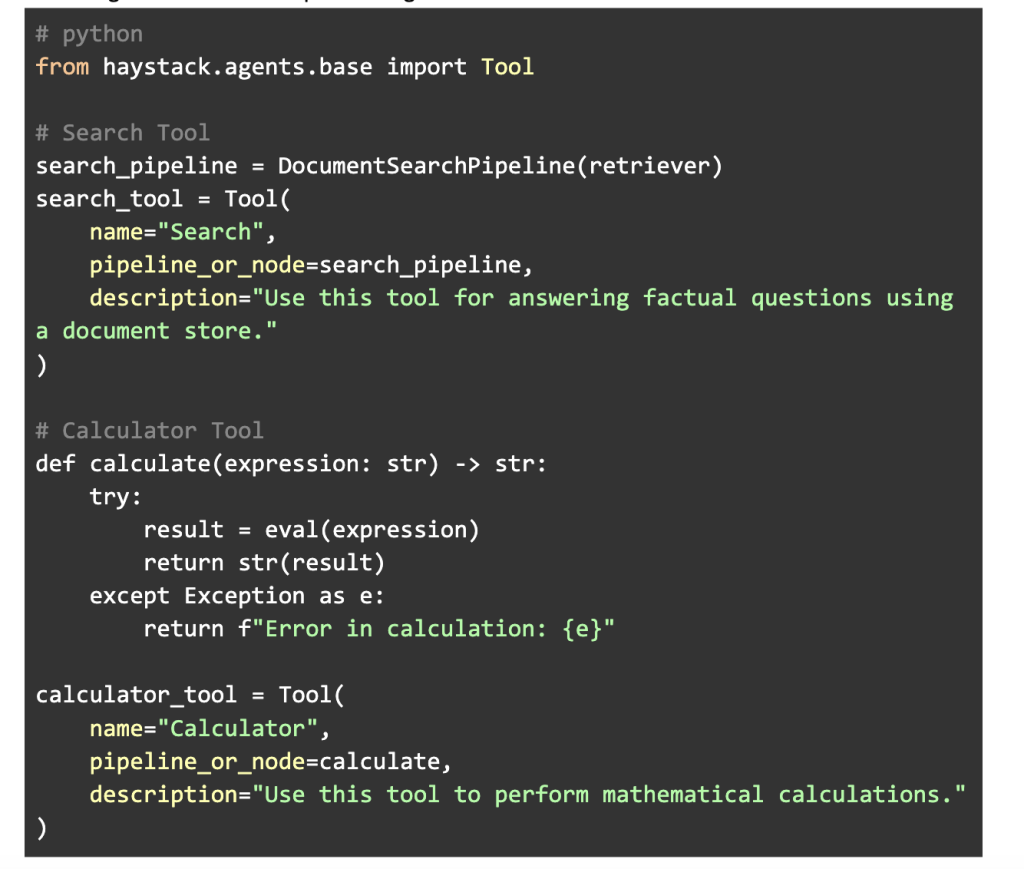

Modern NLP applications often demand multi-step reasoning, interaction with external tools, and the ability to adapt dynamically to user queries. Haystack Agents, an innovative feature of the Haystack NLP framework by deepset, exemplifies this new wave of advanced NLP capabilities.
Haystack Agents are built to handle scenarios requiring:
- Complex multi-step reasoning.
- Integration of external tools or APIs.
- Retrieval-augmented workflows that go beyond simple question answering.
This article delves deep into the Haystack Agents framework, exploring its features, architecture, and real-world applications. To provide practical insights, we’ll build a QA Agent that uses tools like a search engine and a calculator.
Why Choose Haystack Agents?
Unlike general-purpose frameworks such as LangChain, Haystack Agents are deeply integrated within the Haystack ecosystem, making them highly effective for specialized tasks like document retrieval, custom tool integration, and multi-step reasoning. These agents excel in searching through large datasets using advanced retrievers, extending functionality by incorporating APIs for tasks such as calculations or database queries, and addressing complex queries requiring logical deductions. Being open-source and modular, Haystack Agents seamlessly integrate with popular ML libraries and infrastructures like Elasticsearch, Hugging Face models, and pre-trained transformers.
Architecture of Haystack Agents
Haystack Agents are structured using a tool-driven architecture. Here, tools function as individual modules designed for specific tasks, such as document search, calculations, or API interactions. The agent dynamically determines which tools to use, the sequence of their use, and how to combine their outputs to generate a coherent response. The architecture includes key components like tools, which execute specific action prompts that guide the agent’s decision-making process. These retrievers facilitate document search within large datasets, and nodes and pipelines manage data processing and workflow orchestration in Haystack.
Use Case: Building a QA Agent with Search and Calculator Tools
For this tutorial, our QA Agent will perform the following:
- Retrieve answers to factual questions from a document store.
- Perform mathematical calculations using a calculator tool.
- Dynamically combine results when required.
Step 1: Install Prerequisites
Before diving into the implementation, ensure your environment is set up:
1. Install Python 3.8 or higher.
2. Install Haystack with all dependencies:
# bash
pip install farm-haystack[all]3. Launch Elasticsearch, the backbone of our document store:
# bash
docker run -d -p 9200:9200 -e "discovery.type=single-node" docker.elastic.co/elasticsearch/elasticsearch:7.17.1Step 2: Initialize the Document Store and Retriever
The document store is the central repository for storing and querying documents, while the retriever finds relevant documents for a given query.
# python
from haystack.utils import launch_es
from haystack.nodes import EmbeddingRetriever
from haystack.pipelines import DocumentSearchPipeline
from haystack.document_stores import ElasticsearchDocumentStore
# Launch Elasticsearch
launch_es()
# Initialize Document Store
document_store = ElasticsearchDocumentStore()
# Add documents to the store
docs = [
{"content": "Albert Einstein was a theoretical physicist who developed the theory of relativity."},
{"content": "The capital of France is Paris."},
{"content": "The square root of 16 is 4."}
]
document_store.write_documents(docs)
# Initialize Retriever
retriever = EmbeddingRetriever(
document_store=document_store,
embedding_model="sentence-transformers/all-MiniLM-L6-v2",
use_gpu=True
)
# Update embeddings
document_store.update_embeddings(retriever)Step 3: Define Tools
Tools are the building blocks of Haystack Agents. Each tool serves a specific purpose, like searching for documents or performing calculations.
# python
from haystack.agents.base import Tool
# Search Tool
search_pipeline = DocumentSearchPipeline(retriever)
search_tool = Tool(
name="Search",
pipeline_or_node=search_pipeline,
description="Use this tool for answering factual questions using a document store."
)
# Calculator Tool
def calculate(expression: str) -> str:
try:
result = eval(expression)
return str(result)
except Exception as e:
return f"Error in calculation: {e}"
calculator_tool = Tool(
name="Calculator",
pipeline_or_node=calculate,
description="Use this tool to perform mathematical calculations."
)Step 4: Initialize the Agent
Agents in Haystack are configured with tools and a prompt template that defines how they interact with the tools.
# python
from haystack.agents import Agent
# Initialize Agent
agent = Agent(
tools=[search_tool, calculator_tool],
prompt_template="Answer questions using the provided tools. Combine results if needed."
)Step 5: Query the Agent
Interact with the agent by posing natural language queries.
# python
# Factual Question
response = agent.run("Who developed the theory of relativity?")
print("Agent Response:", response)
# Mathematical Calculation
response = agent.run("What is the result of 8 * (2 + 3)?")
print("Agent Response:", response)
# Combined Query
response = agent.run("What is the square root of 16, and who developed it?")
print("Agent Response:", response)Advanced Features of Haystack Agents
- Custom Tools: Integrate APIs or domain-specific tools to extend functionality (e.g., weather APIs, stock market data).
- Fine-Tuned Models: Replace the default embedding model with a fine-tuned one for specialized tasks.
- Chained Pipelines: Use multiple pipelines to process complex queries involving multiple data sources.
In conclusion, Haystack Agents offer a powerful, flexible, and modular framework for building advanced NLP applications that require dynamic multi-step reasoning and tool usage. With their seamless integration into the Haystack ecosystem, these agents excel in tasks like document retrieval, custom API integration, and logical processing, making them ideal for solving complex real-world problems. They are particularly well-suited for applications such as customer support bots, which combine document search with external APIs for real-time ticket resolution, educational tools that retrieve information and perform calculations to answer user queries, and business intelligence solutions that aggregate data from multiple sources and generate insights.
Sources
- https://github.com/deepset-ai/haystack
- https://docs.haystack.deepset.ai/docs/intro
- https://hub.docker.com/_/elasticsearch
- https://github.com/UKPLab/sentence-transformers
Also, don’t forget to follow us on Twitter and join our Telegram Channel and LinkedIn Group. Don’t Forget to join our 65k+ ML SubReddit.
The post What are Haystack Agents? A Comprehensive Guide to Tool-Driven NLP with Code Implementation appeared first on MarkTechPost.
Source: Read MoreÂ





